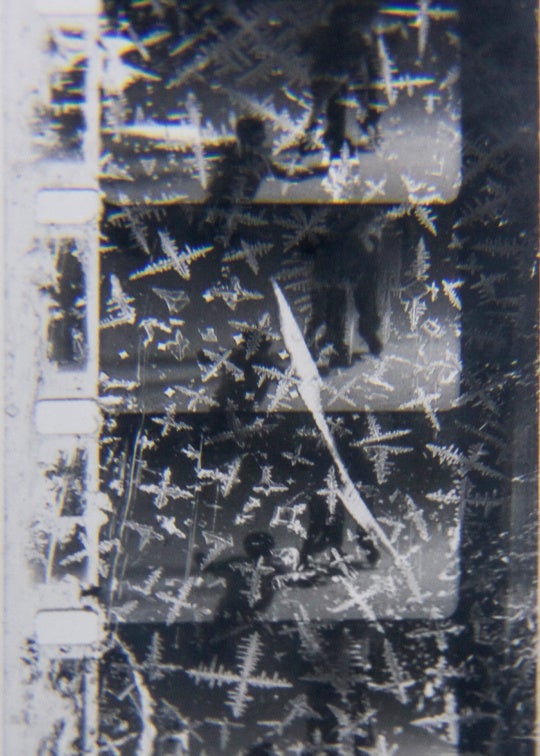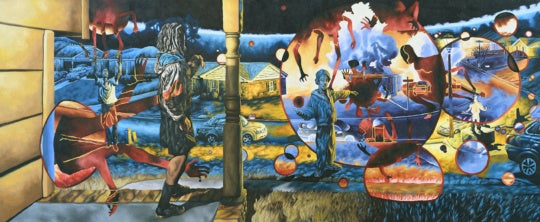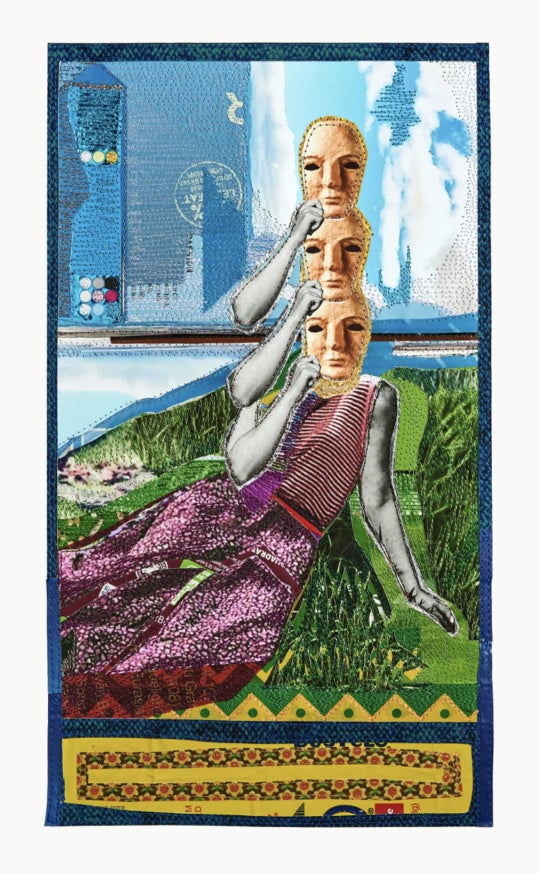
The Afar Triangle is a desert region that encompasses Ethiopia, Djibouti and Eritrea. It is also the fierce, sun-blasted subject of Janet Biggs’s most recent video, Afar, one of her most eloquent to date. In it, she precisely, intuitively, and with utmost care balances the emotional, the political, and the metaphoric into a kind of docu-meditation that is her hallmark. It debuted on June 23 at the SCAD Museum of Art in Savannah, and is on view there through September 25. A visually stunning, immersive, three-channel installation of crystalline clarity, each projection is an extended rectangle aligned across the gallery wall, an insistently long, horizontal format that signifies the infinite vastness of the land she references. Originally, the Brooklyn-based artist known for her travels to remote and difficult lands (including the Arctic Circle, the Taklamakan Desert, and Indonesian sulfur mines), had considered showing the piece in three independent physical spaces, one dedicated to each of the countries visited, but then realized it couldn’t be broken up; she wanted to underscore how truly endless the land there is, and how contingent its borders are.
Just under nine minutes, the video intercuts scenes of the Danakil Depression, the desert, salt flats, volcanoes, nomads, workers and the Afar militia, with segments featuring Elizabeth Streb dancers. It shifts from panoramas of unearthly splendor to sensitive close-ups of the faces of the local inhabitants, who are often regal, often suspicious, and even hostile, underscoring the complex, double-edged nature of otherness. “There was no way I could be a fly on the wall in these places. It is always confrontational, combustible,” she says. Biggs was inspired initially by reading about the region; what stood out for her was that all sources described the Afar Triangle as the most inhospitable place in the world, with average temperatures of 110-120 degrees. Biggs wanted to know what it was like to live in the most unlivable place there is, since people do live and work there. They are also possessive of it, willing to die defending it.

Biggs went there twice, once in the fall of 2014 and a second time in the spring of 2016, supported by SCAD, and accompanied by Luke Cape as her assistant. “I wanted to find a way to show the life of nomads, of unstable borders, of shifting plate tectonics, of a volcanic, earthquake-prone landscape that is as unstable and violent as its political situation.” But she also wanted to capture its “sense of community, identity and place,” she continued. Once she saw the footage, however, she found it problematic. There were so many beautiful shots of African men with guns, but she didn’t want to focus on that, and eventually took out all the images of the Ethiopian army. There wasn’t enough time for her to make that kind of political statement. “I wanted it to be more poetical than political, given the constraints of the project. The camera never quite captures the depth and complexity that’s there and yet I hoped to get some of it—as well as the dignity of the people I am filming. And I’m always aware of the possibility of failure.”

Biggs had conceived it as a three-part film to correlate with the three countries that comprise the Afar territory, but in the end, she couldn’t enter Eritrea (although she is preparing to visit it in the near future). When she lost her third site, she found a replacement almost accidentally. Projects like hers are always a risky venture, vulnerable to unexpected situations. One such unsettling incident was when their guide and driver, upon whom they were totally reliant, threatened to abandon them. They were stuck in a city, virtually as hostages, until the terms of payment were renegotiated. While there, Biggs saw a police van parked in a square. “It had metal screens like a cage so that what was inside was visible,” she described. There was an election or a political event about to take place and the authorities were rounding up Afar children and throwing them into the van. They ranged in age from six to ten years old, and the temperature was about 122 degrees. “The police kept them locked up for hours until one little girl, in desperation, began to throw herself against the metal screen. The police then climbed in with nightsticks and beat them viciously, breaking their bones, bloodying them, then left the injured kids inside. Many died. I was told that this happened frequently and that the bodies would just be dumped in the desert.”
She knew that she needed to commemorate this, to make this the third side of Afar. She immediately thought of the experimental choreographer Elizabeth Streb, who agreed to collaborate with Biggs; her other collaborator, musician Will Martina, created the haunting soundtrack. “I replicated the grill and we worked on the choreography, which resulted in the dancers hurling themselves against it,” she explained. There is one startling scene in which a dancer throws himself against the metal screen, four times or so in quick succession. Accompanied by the grating sound of flesh and bone against metal, it recalls how Biggs had described the little girl’s frantic movements in the van. “I needed to remember that and to document it in my way. This was when it stopped being a documentary and became an artwork.”
When asked if and how this journey had affected her, Biggs answered, “I‘m still trying to articulate that but, of course, it very much did. How could it not?”
Curated by Alexandra Sachs, “Afar” is on view at SCAD Museum of Art through September 25.
Lilly Wei is a New York-based critic and curator whose writing has appeared in such publications as Art in America, Art & Auction, and Artnews.




